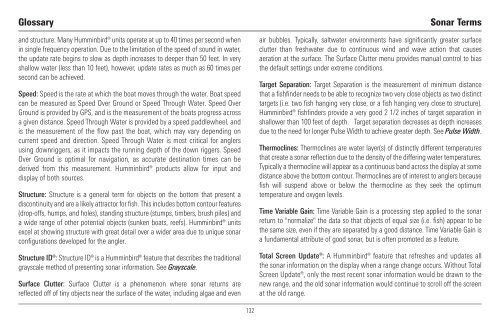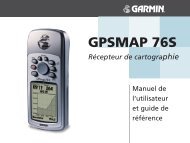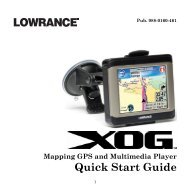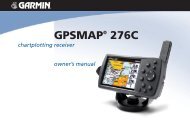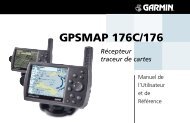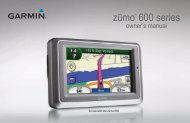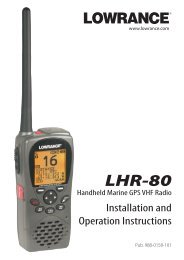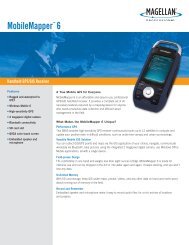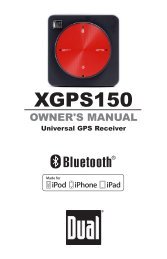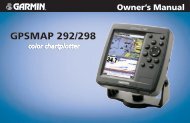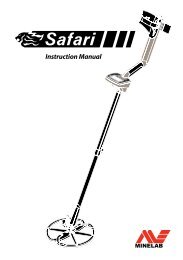Humminbird - Fish Finders and GPS
Humminbird - Fish Finders and GPS
Humminbird - Fish Finders and GPS
Create successful ePaper yourself
Turn your PDF publications into a flip-book with our unique Google optimized e-Paper software.
Glossary<br />
<strong>and</strong> structure. Many <strong>Humminbird</strong>® units operate at up to 40 times per second when<br />
in single frequency operation. Due to the limitation of the speed of sound in water,<br />
the update rate begins to slow as depth increases to deeper than 50 feet. In very<br />
shallow water (less than 10 feet), however, update rates as much as 60 times per<br />
second can be achieved.<br />
Speed: Speed is the rate at which the boat moves through the water. Boat speed<br />
can be measured as Speed Over Ground or Speed Through Water. Speed Over<br />
Ground is provided by <strong>GPS</strong>, <strong>and</strong> is the measurement of the boats progress across<br />
a given distance. Speed Through Water is provided by a speed paddlewheel, <strong>and</strong><br />
is the measurement of the flow past the boat, which may vary depending on<br />
current speed <strong>and</strong> direction. Speed Through Water is most critical for anglers<br />
using downriggers, as it impacts the running depth of the down riggers. Speed<br />
Over Ground is optimal for navigation, as accurate destination times can be<br />
derived from this measurement. <strong>Humminbird</strong>® products allow for input <strong>and</strong><br />
display of both sources.<br />
Structure: Structure is a general term for objects on the bottom that present a<br />
discontinuity <strong>and</strong> are a likely attractor for fish. This includes bottom contour features<br />
(drop-offs, humps, <strong>and</strong> holes), st<strong>and</strong>ing structure (stumps, timbers, brush piles) <strong>and</strong><br />
a wide range of other potential objects (sunken boats, reefs). <strong>Humminbird</strong>® units<br />
excel at showing structure with great detail over a wider area due to unique sonar<br />
configurations developed for the angler.<br />
Structure ID®: Structure ID® is a <strong>Humminbird</strong>® feature that describes the traditional<br />
grayscale method of presenting sonar information. See Grayscale.<br />
Surface Clutter: Surface Clutter is a phenomenon where sonar returns are<br />
reflected off of tiny objects near the surface of the water, including algae <strong>and</strong> even<br />
Sonar Terms<br />
air bubbles. Typically, saltwater environments have significantly greater surface<br />
clutter than freshwater due to continuous wind <strong>and</strong> wave action that causes<br />
aeration at the surface. The Surface Clutter menu provides manual control to bias<br />
the default settings under extreme conditions.<br />
Target Separation: Target Separation is the measurement of minimum distance<br />
that a fishfinder needs to be able to recognize two very close objects as two distinct<br />
targets (i.e. two fish hanging very close, or a fish hanging very close to structure).<br />
<strong>Humminbird</strong>® fishfinders provide a very good 2 1/2 inches of target separation in<br />
shallower than 100 feet of depth. Target separation decreases as depth increases<br />
due to the need for longer Pulse Width to achieve greater depth. See Pulse Width.<br />
Thermoclines: Thermoclines are water layer(s) of distinctly different temperatures<br />
that create a sonar reflection due to the density of the differing water temperatures.<br />
Typically a thermocline will appear as a continuous b<strong>and</strong> across the display at some<br />
distance above the bottom contour. Thermoclines are of interest to anglers because<br />
fish will suspend above or below the thermocline as they seek the optimum<br />
temperature <strong>and</strong> oxygen levels.<br />
Time Variable Gain: Time Variable Gain is a processing step applied to the sonar<br />
return to "normalize" the data so that objects of equal size (i.e. fish) appear to be<br />
the same size, even if they are separated by a good distance. Time Variable Gain is<br />
a fundamental attribute of good sonar, but is often promoted as a feature.<br />
Total Screen Update®: A <strong>Humminbird</strong>® feature that refreshes <strong>and</strong> updates all<br />
the sonar information on the display when a range change occurs. Without Total<br />
Screen Update®, only the most recent sonar information would be drawn to the<br />
new range, <strong>and</strong> the old sonar information would continue to scroll off the screen<br />
at the old range.<br />
132


